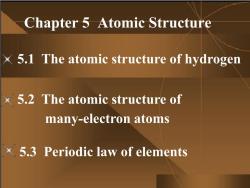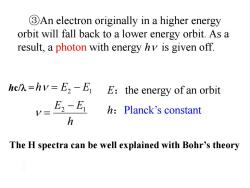北京化工大学:《无机化学》课程电子教案(课件讲稿,2015)Chapter 5 Atomic Structure

Chapter 5 Atomic Structure 5.1 The atomic structure of hydrogen x 5.2 The atomic structure of many-electron atoms x 5.3 Periodic law of elements
5.1 The atomic structure of hydrogen 5.2 The atomic structure of many-electron atoms 5.3 Periodic law of elements Chapter 5 Atomic Structure

5.1 The atomic structure of hydrogen -5.1.1 The hydrogen spectrum and Bohr's theory 5.1.2 The dual nature of the electron 5.1.3 Schrodinger equation and quantum numbers 5.1.4 The ground state of H atoms 5.1.5 The excited state of HAtoms 回
5.1.1 The hydrogen spectrum and Bohr’s theory 5.1 The atomic structure of hydrogen 5.1.5 The excited state of H Atoms 5.1.4 The ground state of H atoms 5.1.3 Schrödinger equation and quantum numbers 5.1.2 The dual nature of the electron

Review of the history on atomic structures Dalton:atomic theory (1803) Thomson:“watermelon”nodel (1904) Rutherford:“core”model (1911) Bohr:“electron layered disposition” (1913) Quantum mechanics theory:(1926)
Review of the history on atomic structures Dalton: atomic theory (1803) Thomson: “watermelon” model (1904) Rutherford: “core” model (1911) Bohr: “electron layered disposition” (1913) Quantum mechanics theory: (1926)

5.1.1 The hydrogen spectrum and Bohr's theory 1.Light:a component of electromagnetic radiation 103m 1m 10-3m 10-6m 10-9m 10-12m 10-15m Long waves Radio waves Infrared Ultraviolet X-rays Gamma rays red orange green grass blue purple Vi-I 5×1014 6×1014 7×1014
1. Light: a component of electromagnetic radiation 5.1.1 The hydrogen spectrum and Bohr’s theory red orange green grass blue purple

2.Emission spectrum of the hydrogen atoms 检测屏 H 400T450T500550T600T650T700m 410.2434.0 486.1 元/hm 7.31 6.91 6.07 (×10)ys C V= 元 c=2.998×108m·s(c:light velocity)
2. Emission spectrum of the hydrogen atoms 8 1 2.998 10 m s c c 光速 Hα 656.3 4.57 Hβ 486.1 6.07 Hγ 434.0 6.91 Hδ 410.2 7.31 /nm1 ( 10 ) /s 1 4 H2 + - (c: light velocity)

The features of hydrogen spectrum: discontinuous spectrum (line spectrum) the frequency of the visible line spectrum meets with the following empirical equation: -329×10(-x n n=3 red红(Ha) n=4 blueness青(HB) n=3,4,5,6,. n=5 blue-purple蓝紫Hy) n=6 purple紫(H6) But what does 2,n,3.289X 1015 mean in the empirical equation?Unclear at that time
• discontinuous spectrum (line spectrum) • the frequency of the visible line spectrum meets with the following empirical equation: 1 2 2 1 5 )s 1 2 1 3.289 10 ( n v n= 3,4,5,6, … But what does 2,n,3.289×1015 mean in the empirical equation? Unclear at that time The features of hydrogen spectrum: n = 3 red 红(Hα) n = 4 blueness 青(Hβ) n = 5 blue-purple 蓝紫(Hγ) n = 6 purple 紫(Hδ)

3.Bohr's theory Three major assumptions of Bohr's theory DAn electron in an atom could be located only in certain orbits that have particular radii and energies; 2Usually,an electron would remain in the orbit which is the most close to the nucleus.The atom is said to be in its ground state under this condition,which corresponds to the most stable energy state;Energy absorbed by the atom causes the electron to move from the orbits close to the nucleus to those far from it,then the atom is said to be in an excited state
3.Bohr’s theory Three major assumptions of Bohr’s theory : ①An electron in an atom could be located only in certain orbits that have particular radii and energies; ②Usually, an electron would remain in the orbit which is the most close to the nucleus. The atom is said to be in its ground state under this condition, which corresponds to the most stable energy state; Energy absorbed by the atom causes the electron to move from the orbits close to the nucleus to those far from it, then the atom is said to be in an excited state

3An electron originally in a higher energy orbit will fall back to a lower energy orbit.As a result,a photon with energy hv is given off. hcl=hv=E2-E E:the energy of an orbit E2-E1 h:Planck's constant h The H spectra can be well explained with Bohr's theory
③An electron originally in a higher energy orbit will fall back to a lower energy orbit. As a result, a photon with energy h is given off. h E E h E E 2 1 2 1 E:the energy of an orbit h:Planck’s constant The H spectra can be well explained with Bohr’s theory hc/ =

The energy levels in the H atom and the various emission series 7 6 5 Brackett series Paschen series Balmer series 328x10(z·1 Lyman n=3red红(Ha,n=4 blueness青(Hg) n=5blue-purplej蓝紫(H,n=6 purple紫(H) series '450T500550TT600T50
Balmer series Lyman series Paschen series Brackett series n = 3 red 红(Hα ), n = 4 blueness青(Hβ ) n = 5 blue-purple蓝紫(Hγ ), n = 6 purple紫(Hδ ) = 3.2891015( - )s 1 -1 2 2 1 n 2 The energy levels in the H atom and the various emission series

=3.289x10(1 n2 n2>n1 △E=hy =6.626×1034Js×3289×1015( n n =2.179x101(1 2 2 RH:Rydberg constant, n 2.179×10-18J
-1 2 2 2 1 1 5 )s 1 1 3.289 1 0 ( n n v n2 n1 E hv RH:Rydberg constant, 2.179×10-18J. ) 1 1 ( 2 2 2 1 H n n E R )J 1 1 2.179 10 ( 2 2 2 1 -1 8 n n -1 2 2 2 1 3 4 1 5 )s 1 1 6.626 10 J s 3.289 10 ( n n
按次数下载不扣除下载券;
注册用户24小时内重复下载只扣除一次;
顺序:VIP每日次数-->可用次数-->下载券;
- 北京化工大学:《无机化学》课程电子教案(课件讲稿,2015)Chapter 4 Chemical equilibria.pdf
- 北京化工大学:《无机化学》课程电子教案(课件讲稿,2015)Chapter 2 Basic of thermodynamics.pdf
- 北京化工大学:《无机化学》课程电子教案(课件讲稿,2015)Chapter 1 Preface(负责人:周云山).pdf
- 北京化工大学:《无机化学》课程电子教案(PPT课件,2013)Chapter 9 Molecular Structure.ppt
- 北京化工大学:《无机化学》课程电子教案(PPT课件,2013)Chapter 8 Atomic Structure.ppt
- 北京化工大学:《无机化学》课程电子教案(PPT课件,2013)Chapter 7 Redox Reactions and the Base of Electrochemistry.ppt
- 北京化工大学:《无机化学》课程电子教案(PPT课件,2013)Chapter 16 The d-block elements(Ⅰ).ppt
- 北京化工大学:《无机化学》课程电子教案(PPT课件,2013)Chapter 15 The p-block elements(Ⅲ).ppt
- 北京化工大学:《无机化学》课程电子教案(PPT课件,2013)Chapter 14 Chapter 14 The p-block elements(Ⅱ).ppt
- 北京化工大学:《无机化学》课程电子教案(PPT课件,2013)Chapter 13 The p-block elements(Ⅰ).ppt
- 北京化工大学:《无机化学》课程电子教案(PPT课件,2013)Chapter 12 The s-Block Elements.pptx
- 北京化工大学:《无机化学》课程电子教案(PPT课件,2013)Chapter 11 Coordination Compound Structures.ppt
- 北京化工大学:《无机化学》课程电子教案(PPT课件,2013)Chapter 10 Solid Structure.pptx
- 北京化工大学:《无机化学》课程电子教案(教学课件,2012)Chapter 4 Chemical equilibria, entropy and Gibbs function.pdf
- 北京化工大学:《无机化学》课程电子教案(PPT课件,2013)Chapter 4 Chemical equilibria, entropy and Gibbs function.ppt
- 北京化工大学:《无机化学》课程电子教案(PPT课件,2013)Chapter 6 Precipitation-Solubility Equilibria.ppt
- 北京化工大学:《无机化学》课程电子教案(PPT课件,2013)Chapter 5 Acid-Base Equilibrium.ppt
- 北京化工大学:《无机化学》课程电子教案(PPT课件,2013)Chapter 2 Thermochemistry.ppt
- 北京化工大学:《无机化学》课程电子教案(PPT课件,2013)Chapter 1 Preface.ppt
- 北京化工大学:《无机化学》课程电子教案(教学课件,2012)Chapter 8 Atomic Structure.pdf
- 北京化工大学:《无机化学》课程电子教案(课件讲稿,2015)Chapter 6 Molecular Structure and covalent bond theory.pdf
- 北京化工大学:《无机化学》课程电子教案(课件讲稿,2015)Chapter 7 Crystal Structure.pdf
- 北京化工大学:《无机化学》课程电子教案(课件讲稿,2015)Chapter 8 Acid-Base Equilibrium.pdf
- 北京化工大学:《无机化学》课程电子教案(课件讲稿,2015)Chapter 9 Precipitation-Solubility Equilibria.pdf
- 北京化工大学:《无机化学》课程电子教案(课件讲稿,2015)Chapter 10 Reduction - oxidization Reactions.pdf
- 北京化工大学:《无机化学》课程电子教案(课件讲稿,2015)Chapter 11 Basic of Coordination Chemistry.pdf
- 北京化工大学:《无机化学》课程电子教案(课件讲稿,2015)Chapter 12 The alkali and alkaline earth metal.pdf
- 北京化工大学:《无机化学》课程电子教案(课件讲稿,2015)Chapter 13 The elements of boron family.pdf
- 北京化工大学:《无机化学》课程电子教案(课件讲稿,2015)Chapter 14 The elements of carbon family.pdf
- 北京化工大学:《无机化学》课程电子教案(课件讲稿,2015)Chapter 15 The elements of nitrogen family.pdf
- 北京化工大学:《无机化学》课程电子教案(课件讲稿,2015)Chapter 16 The elements of oxygen family.pdf
- 北京化工大学:《无机化学》课程电子教案(课件讲稿,2015)Chapter 17 The halogens.pdf
- 北京化工大学:《无机化学》课程电子教案(课件讲稿,2015)Chapter 18 Hydrogen and the rare gases.pdf
- 北京化工大学:《无机化学》课程电子教案(课件讲稿,2015)Chapter 19 The elements of copper and zinc family.pdf
- 北京化工大学:《无机化学》课程电子教案(课件讲稿,2015)Chapter 21 The elements of chromium and Manganese family.pdf
- 北京化工大学:《无机化学》课程电子教案(课件讲稿,2015)Chapter 22 The elements of iron and platinium families.pdf
- 广东医科大学:《有机化学》课程教学资源(教学大纲)有机化学教学大纲(药学专业)Organic Chemistry.pdf
- 广东医科大学:《有机化学》课程电子教案(课件讲稿)第一章 绪论 Organic Chemistry(负责人:杨雪梅).pdf
- 广东医科大学:《有机化学》课程电子教案(课件讲稿)第三章 烯烃 Alkenes.pdf
- 广东医科大学:《有机化学》课程电子教案(课件讲稿)第二章 烷烃和环烷烃 Alkane and Cycloalkane.pdf
